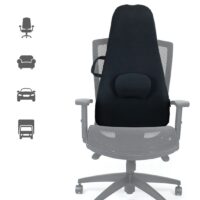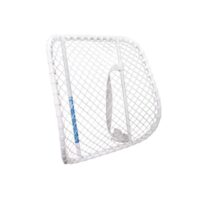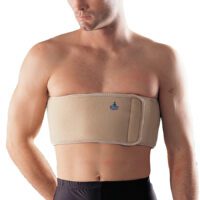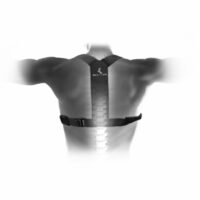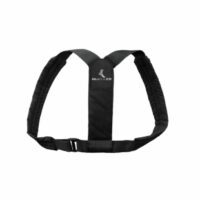Rib Stress Fracture
Article by J. Miller, S.Armfield

Rib Stress Fracture
Rib stress fractures differ from traditional fractures. Repetitive overloading causes the formation of microscopic cracks in the weakened area of the bone, instead of a single traumatic event causing the bone to crack or break. This unique feature necessitates a tailored treatment approach.
Stress fractures in the ribs are rare but can result from repetitive or increased loading. Commonly affected ribs are 1st anterolaterally and 4th-9th laterally and posterolaterally. Upper ribs posteromedially can also be affected. Early detection is critical due to the potential for severe pain and the need for prompt treatment.
What Causes Stress Fractures of the Ribs?
Rib stress fractures commonly occur in sports that involve repetitive and forceful movements, such as rowing. Research has identified two main factors that contribute to the development of rib stress fractures: the amount of rib loading and the body’s response to that loading.
Muscular factors, such as muscle weakness or muscular imbalances, can decrease the shock absorption capabilities of the muscle, resulting in an increased level of stress on the selected focal point of the rib(s). Additionally, the repeated exertion of considerable force across the bone can also contribute to rib stress fractures.
Training, sex, age, and skeletal factors can also contribute to the onset of rib stress fractures. Poor technique in sports, old or damaged equipment, lack of flexibility or strength, and a non-graduated increase in training load are all examples of training-related factors that can increase the risk of rib stress fractures. Additionally, stiff joints between the ribs and the vertebrae can decrease the ability to dissipate forces through-loading.
Furthermore, female sex steroid hormones have been identified as potentially contributing to the pathogenesis of rib stress fractures. Additionally, decreased bone mineral density with age can also increase the risk of developing rib stress fractures. (Rumball, Lebrun, Di Ciacca & Orlando, 2005)
Common Rib Stress Fracture Symptoms
Rib stress fractures usually manifest as a gradual onset of chest or back pain, without a specific mechanism of injury, which may improve with rest. Coughing, sneezing, rolling over in bed, doing push-ups or sit-ups, and pushing open a door often exacerbate the pain.
As pain persists, it may become specific and bony formation may develop. Diagnosis is crucial as symptoms mimic other conditions. Imaging tests confirm the diagnosis of rib stress fractures.
Rib Stress Fracture Investigations
When diagnosing rib stress fractures, a plain film X-ray is often insufficient. A bone scan or MRI are the gold standard for imaging. These tests are generally indicated if the pain persists and conservative treatment fails. A CT scan may also be used in some cases. Consulting a healthcare professional is crucial.
Rib Stress Fracture Treatment
The treatment of rib stress fractures typically involves three phases:
Phase 1: Early Injury Protection
This includes pain reduction measures such as rest, supported coughing, ice, and anti-inflammatory medications. Your physiotherapist will determine the extent of your injury and recommend a relative period of rest.
Phase 2: Range of Motion Restoration
This phase involves soft tissue release work of the surrounding musculature, joint mobilisations to address stiff joints, and pain-free exercises to prevent muscle wasting.
Phase 3: Return to Sport
In this phase, the focus is on sport-specific technique modification to prevent regression in the improvement and reduce the likelihood of re-injury. A graduated return to sport is initiated, and pain is the primary mediator in the amount of exercise that can be performed.
Before returning to modified training, the individual must be able to complete the seven criteria pain-free, which include push-ups, sit-ups, deep breaths, coughs, rib spring, night pain, and activities of daily living.
For rowers with rib stress fractures, it is recommended to follow the guidelines provided by the Australian Institute of Sport, National Rowing Centre of Excellence.
Conclusion
In conclusion, rib stress fractures can be a painful and debilitating injury, commonly seen in athletes participating in high-impact sports. The causes of these fractures are multifactorial and include muscular weakness, poor technique, and lack of flexibility and strength. The diagnosis can be challenging, and specialised imaging techniques may be required.
The treatment of rib stress fractures typically involves a multidisciplinary approach, including rest, pain reduction, soft tissue release work, joint mobilisations, and a graduated return to sport program. Prevention is key, and athletes should focus on maintaining proper technique, adequate strength and flexibility, and appropriate training load progression.
If you are experiencing any symptoms of rib stress fractures or have concerns about your training program, it is essential to seek the advice of a healthcare professional, such as a physiotherapist or sports medicine specialist.
In summary, rib stress fractures require early identification and appropriate management to ensure a positive prognosis. By taking proactive steps to prevent injury and seeking prompt medical attention, athletes can continue to enjoy their sport safely and effectively.
Related Articles
- Thoracic Facet Joint Pain: Offers an understanding of how facet joint issues contribute to upper back discomfort.
- Thoracic Outlet Syndrome: Explains the condition, symptoms, and treatment options for this syndrome affecting the nerves and blood vessels in the upper back and neck area.
- Manage Your Upper Back Pain: Physiotherapist Insights: Provides physiotherapy-based insights on managing upper back pain, including common causes and treatments.
- Posture Correction: Highlights the importance of posture in preventing and managing upper back pain, offering tips for improvement.
- Osteoporosis: Examines the link between osteoporosis and upper back pain, along with prevention and management strategies.
- Posture Exercises: Suggests exercises to improve posture and alleviate upper back pain.
- Scheuermann’s Disease: Provides information on Scheuermann’s Disease, a condition affecting the spine that can cause upper back pain.
- Scoliosis: Offers insights into how scoliosis can impact upper back pain and suggests treatment options.
- Ankylosing Spondylitis, Fibromyalgia, and Rheumatoid Arthritis: These articles discuss systemic diseases that can cause upper back pain and their management strategies.
Effective Management of Upper Back Pain and Injury
Physiotherapy Insights
Introduction
Upper back pain and injury, predominantly affecting the thoracic spine, are prevalent issues causing significant discomfort and impacting daily activities. This article, infused with physiotherapy insights, aims to enlighten the general public about the causes, symptoms, and treatment options for upper back pain.


Managing Upper Back Pain
Upper back pain stems from various sources, including thoracic spine conditions, joint injuries, muscle strains, nerve irritations, and systemic diseases. Recognising these causes is vital for appropriate treatment.
Common Causes of Upper Back Pain
- Joint Injuries: Facet joint pain is a frequent issue.
- Muscle-Related Injuries: This includes back muscle pain, side strains, whiplash, muscle cramps, and DOMS (Delayed Onset Muscle Soreness).
- Bone-Related Injuries: Conditions like Scheuermann's Disease, Scoliosis, and others.
- Disc-Related Injuries: Including bulging, slipped, or herniated discs.
- Nerve-Related Pain: Such as thoracic outlet syndrome and pinched nerves.
- Systemic Diseases: These include Ankylosing Spondylitis, Fibromyalgia, and arthritis types.
Posture and Upper Back Pain
Poor posture is a significant contributor to upper back pain. Understanding and correcting sitting, standing, and sleeping postures can prevent and alleviate pain.
Physiotherapy Perspective
A physiotherapist's approach to treating upper back pain involves assessing the individual's condition and tailoring a treatment plan. This may include exercises, manual therapy, and advice on posture correction.
Latest Research and Techniques
Recent advancements in physiotherapy have introduced innovative methods for treating upper back pain. These include targeted exercises, advanced manual techniques, and utilisation of posture-improving products.
What to Do?
If you experience upper back pain, it's crucial to consult a physiotherapist for a professional assessment and personalised treatment plan.
Conclusion
Upper back pain, though common, can be effectively managed with the right approach. Understanding its causes and seeking professional physiotherapy advice are key steps towards recovery.
For more information, explore articles at PhysioWorks.
Related Articles
Joint Injuries
Muscle-Related Injuries
Bone-Related Injuries
Disc-Related Injuries
Nerve-Related / Referred Pain
Systemic Diseases
Posture Information
- Posture Syndromes
- Posture Improvement: A Guide to Improve Your Posture
- Improving Your Posture: A Guide for Better Health
- How to Achieve Perfect Posture




















